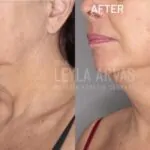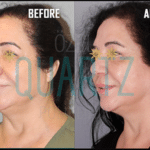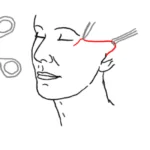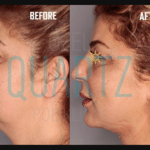 There are lots of patients who are somehow not satisfied with existing facial features and suffer from wrinkles or sagging on the face. Nowadays Thread Lift is one of the non-surgical face lift operations for people who do not want to go for surgical procedures. It is one of the solutions to get rid of the sagging and prevention treatment for the future aging process.
There are lots of patients who are somehow not satisfied with existing facial features and suffer from wrinkles or sagging on the face. Nowadays Thread Lift is one of the non-surgical face lift operations for people who do not want to go for surgical procedures. It is one of the solutions to get rid of the sagging and prevention treatment for the future aging process.
In this article you can find the answers to the questions below:
- How to make a facelift with threads?
- Which threads are more long lasting?
- Which threads are used for which area of the face or body?
- Who is suitable for thread lift?
- How long will the effect after the thread lift last?
How is a Thread Facelift Done?
Thread Lift is an anti-aging non-surgical treatment that lifts the patient’s skin and prevents the future sagging. It is generally performed under local anesthesia and takes usually around 45 minutes. It doesn’t change the main features of the patient but helps the patient look younger and provides a natural look.
Before starting the procedure, the doctor examines the patient and does the necessary markup to confirm where exactly lifting will be performed and exclude any possible mistake. For the patient’s comfort before actual thread lifting the local anesthetic cream is applied. For patients who are more sensitive to pain the local anesthesia may be applied too. Anastasia excludes any discomfort for both patient and doctor who performed treatment. After all preparations are finished the doctor places the threads with the help of tiny needles under the patient’s skin in marked areas.
Which Types of Threads are Used in Thread Lift?
There are two main types of threads used in thread facelift. The main types of threads are “Polylactic acid” threads and “Polydioxanone (PDO)” threads. The main difference of these threads is that they are absorbed by the body in a short time, stimulating the reparative cells under the skin in the area where they are placed, increasing collagen production and providing tightening of the skin. It takes about 10-12 weeks for them to melt completely under the skin and the tightening effect they create continues for about 3 months after the operation. Apart from these thread types, there are also threads containing caprolactone, which are not commonly used.
What Brands of Threads are Preferred for Facelift?
Tess Lift Facelift Method
Tess Lift threads are not absorbable threads. It is used to lift the face, neck, cheeks and eyebrow area. It is ideal for patients who do not have much sagging on the face and who are relatively young. The threads used in this application are made of polypropylene and do not melt in the body. It is one of the threads used in surgery. Therefore, although they remain in the body for life, they do not cause any reaction. It is placed on the face through a cannula and when the cannula is taken out, the threads remain under the skin. After being placed under the skin, and lifted, the remaining parts of the threads are cut so that they cannot be seen or felt.
Silhouette Soft Thread Facelift Method
It is the method where polylactic acid (PLA) threads are used in the non-surgical facelift procedure. When these threads are placed under the skin, they act as suspenders on the skin thanks to the 8-12-16 cones on them. They increase the amount of collagen in the skin and the rate of regeneration, and they disappear over time.
PDO Thread Facelift Method
It is the method applied with flat, awned or cross-knitted PDO threads of different diameters and structures. As with other PDO threads, the skin is lifted after they are placed under the skin. Its effect is visible in the first 3 months and lasts for about 2 years. It is used for lifting the cheeks, eyebrows, eyelids, forehead, chin and neck areas.
Spring Thread Facelift Method
The threads used in this method, also known as French Threads or Dynamic Threads, are made of silicone. They are permanent and flexible threads. Their effect lasts much longer than other threads. The permanence of facelift procedures performed with this thread can last for approximately 4-5 years. They are used for sagging face, neck, chest, arms, legs, buttocks and abdomen. Although these threads are popular and frequently used, they also have a disadvantage for the patients with very thin skin, they may be visible under the skin over time due to their thicker structure.
What Types of Threads are Used in Thread Facelift?
There are different types of threads used in thread facelift; they are classified according to their lasting effect and structure in the tissue.
There are permanent and temporary threads according to the duration of their stay in the human tissue. Permanent threads are threads that do not dissolve in the body over time, but do not cause any reaction. For example, threads such as Thread Lift and Spring Tread.
On the other hand, temporary threads dissolve in the tissue over time. We may add to this group Silhouette Soft Threads. According to the structure of the threads, they are divided into 2 groups, straight and notched/hooked/awn yarns. Flat threads, like suture threads used in surgery, have a flat surface and are frequently used in face suspension. Notched/hooked/awn threads are threads that have embossments and hooks on their surface and are frequently used depending on the technique applied by a doctor who performs thread lifting.
Who is the Good Candidate for Thread Facelift?
 Thread facelift is an ideal method for people who do not have too much developed skin due to sagging and have less superficial wrinkles.
Thread facelift is an ideal method for people who do not have too much developed skin due to sagging and have less superficial wrinkles.
Those who have sagging and loosening in various parts of their face, who want their skin to regenerate and have a more youthful look, and it is an ideal solution for those who do not want to have surgery and go under general anesthesia.
Thread facelift generally applied to the 35-50 age group of patients, but if there is not much sagging and deformation, it also can be applied to the older group of patients.
It gives amazing results, especially in cases where the mouth and chin area look droopy, and can also be used safely in the neck area.
Is Thread Facelift Suitable for All Skin Types?
Unfortunately, it is not suitable for extremely wrinkled, sagging and deformed skin. Such patients cannot get enough visible results from the thread facelift. For this reason, these people should be directed to facelift surgeries. In cases where the skin is very thick and heavy, the threads are useless, and in cases where the skin is very thin and wrinkled, the process is insufficient. The most suitable candidates for this procedure are people who have thin skin with slight wrinkles and do not have much sagging.
Which Areas Can be Treated Threads?
This procedure is highly recommended for skin sagging in the mouth and jaw line; however, thanks to the new threads and techniques developed today, it is frequently used for face, neck, jowl, eyebrows, cheeks and many other areas nowadays.
Who Has Contraindication for Thread Facelift?
- People over the age of 50 with excessive facial sagging and deformation,
- Those who have very sensitive skin and cannot tolerate threading,
- For those with very thin subcutaneous tissue,
- It is not applied to pregnant women and patients with active infections.
When Does the Thread Facelift Show Visible Effect?
After the procedure, the first effects on the skin appear immediately, it gives the best result after 3 months post treatment. During this period, the threads placed under the skin start the collagen production and skin naturally becomes more supported and tightened.
How Long Does the Results of Threads Last?
Depending on the person’s lifestyle, the effect of the procedure lasts for about 6 months to 5 years, depending on which thread was used during the procedure. In the case of lifting with a silicone-containing thread, this period can be expected to be much longer. Smoking and alcohol consumption can shorten this period. Correctly and professionally performed treatment and patient right post treatment care prolongs the effect of thread lifting.
What are the Main Advantages of Thread Lift?
Since it is not a surgical procedure, general anesthesia is not applied in thread face lift, so the side effects and risks of anesthesia are avoided.
It is a purely medical procedure. There are no interventions, so the patient can easily return to his/her daily life.
In addition to the fact that the procedure is carried out in a very short time, the effects begin as soon as the procedure is over, which immediately raises the patient’s self-confidence. Thread lifting does not change the mimics and natural expression of the patient, the final look of the patient remains natural. The recovery time is short and patients can easily come back to social life without restrictions. The thread lift is not only a solution for sagging but a solution for improving skin quality in general because after the procedure collagen production is increased. There is no possibility of leaving any scar after the treatment. This treatment can be ideal for different patients’ groups.
Is Thread Lift a Painful Procedure?
Thanks to the application of local anesthesia before the procedure, the patient does not feel any pain. The procedure is very comfortable. Very mild swelling and bruises may occur after the procedure; but they disappear in a very short time. Since the skin may be sensitive during the healing process, it is recommended to avoid any topical treatments that will irritate the skin. During this period, the rate of recovery can be increased by applying regular care.
Are There Any Side Effects of Thread Lift?
Minor visible side effects that can be seen after the thread face lift operation are edema, bruising, tenderness and skin irregularities that will pass in a very short time. All these mild side effects disappear completely within 3-5 days.
What to Do Before the Thread lift?
Before this treatment, patients should follow some necessary tips to get the ideal result afterwards. The patient must have been fasting for at least 4 hours, must not have been using blood thinners at least 1 month before the planned procedure, should not have an allergic condition, and should inform the doctor about any medications used on a daily basis. Although it is a simple and non-surgical treatment, it is still a short-term intervention. In order to avoid any complications, thread lifting should be done by an experienced provider and attention should be paid to all details in terms of avoiding any future complications.
What to Do After the Thread lift?
After the thread lift procedure, the patient may immediately return to his/her daily life, antibiotic creams should be applied for about 5 days to prevent any infection. It is highly recommended to avoid doing sports, having a massage, sunbathing, hammam, sauna, solarium and excessive facial treatments for the first 3 weeks.
Can Threadlift be Repeated?
The effect of Thread Lift lasts approximately 2-5 years. At the end of this period, it can be repeated if desired. More permanent threads are silicone threads; their effect lasts about 5-6 years. At the end of this period, the procedure can be repeated. There is no restriction about it.
How Much Does Thread Lift Cost?
The price of the thread lift, the non-surgical procedure that is an ideal solution for wrinkles, sagging and deformations varies according to the number and type of threads that are going to be used. The amount of sagging and wrinkles on the faces of each patient is quite different and varying from patient to patient. That’s why the average price for this treatment will be given after the patient’s personal examination with the doctor.












